Toshiba X305-Q725: Quad-Core Gaming Notebook
by Jarred Walton on March 11, 2009 1:00 AM EST- Posted in
- Laptops
General Application Performance
Wrapping things up with our performance testing, we have results from the Futuremark PCMark testing suites as well as some of our own application benchmarking. When it comes to running your office, multimedia, and Internet tasks, most modern laptops are more than fast enough. What follows are a few of the more strenuous application benchmarks - 3D rendering and video encoding - that put more of an emphasis on high CPU speeds. If you don't do that sort of thing on your computer, you will probably find that just about any Core 2 Duo processor is more than fast enough.
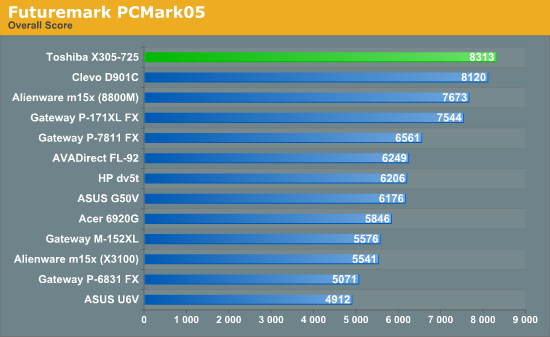
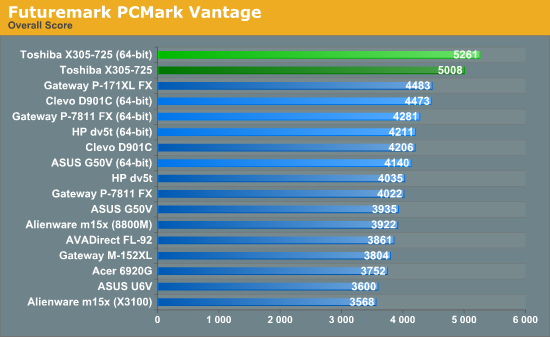
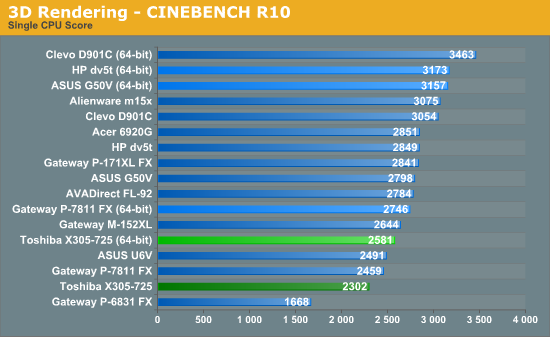

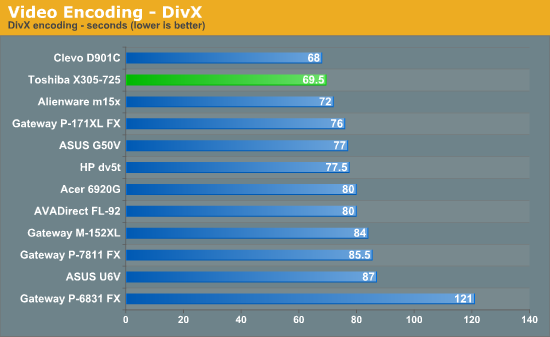
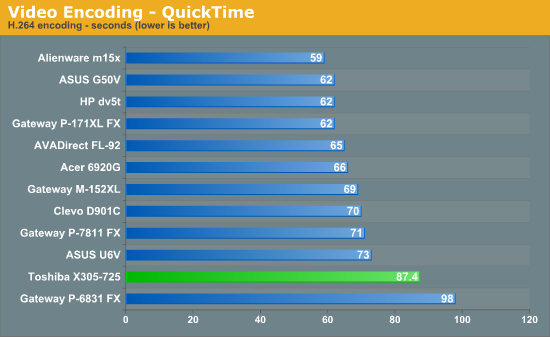
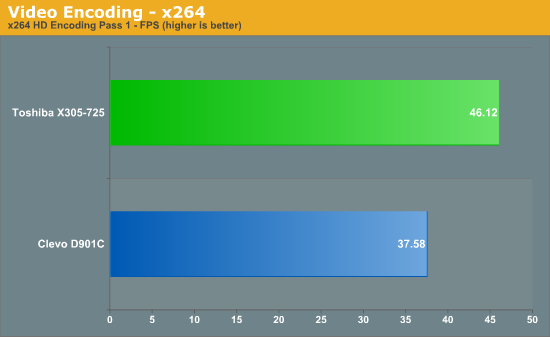
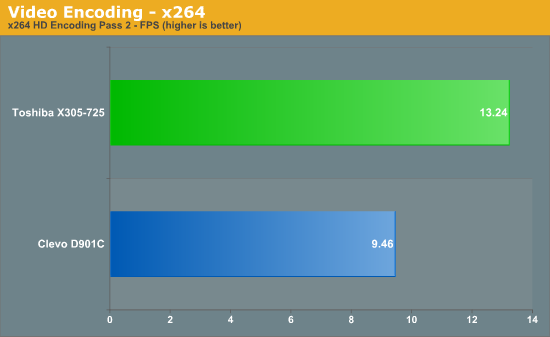
The quad-core CPU in the X305-Q725 does show its muscle in several of these tests, and the SSD helps elsewhere. PCMark definitely benefits the most from the SSD, with several of the tests stressing the ability to stream large amounts of data. Other tests like QuickTime were actually slower with the SSD, because of delays in writing the data. QuickTime also shows a situation that still occurs even with complex tasks on occasion: the lower clocked quad-core CPU ends up being slower than the dual-core CPUs because QuickTime won't utilize more than two CPU cores. DivX also fails to fully utilize the quad-core chip, with the total performance improvement over the E6850 at just 2.2%.
On the other hand, x264 benefits substantially, especially when you factor in clock speeds. Four cores at 2.0GHz theoretically provide up to 8GHz of processing potential, and the two cores of the E6850 at 3.0GHz provide 6GHz of potential, making the maximum theoretical improvement (all other things being equal) just 33%. The E6850 is an older architecture (Conroe instead of Penryn) but the E6850 also has more L2 cache per core; the fact that the Q9000 ends up being 40% faster on the second pass shows that there are scaling benefits from the newer architecture.
3D rendering is often able to scale almost perfectly up through four to six threads, so CINEBENCH R10 multi-core shows a nearly perfect increase of 32%. It's interesting that the single-threaded CINEBENCH score only shows a 33% advantage for the E6850, so again architectural changes in the Penryn core benefit the Q9000.
Overall, the X305-Q725 with the Q9000 looks like a good choice for highly threaded workloads, and the SSD can help in a few instances as well. However, there are competing laptops that offer similar performance for less money, or more performance for a similar cost, which makes the X305-Q725 more difficult to recommend.










32 Comments
View All Comments
Dfere - Thursday, March 12, 2009 - link
A business power user needs some mobility. I use a laptop as my main business computer. It would be nice to have something to play games at an ok rate. But given the bugs, let alone the power issues, I wouldn't. I need some mobility and I need my data and system operational to make revenue.A plain gamer/laptop lover wouldn't because it isn't a top performer, and thats why they buy.
JimmiG - Thursday, March 12, 2009 - link
I used to travel a lot between point A and point B and wanted a good gaming system at both places. I was considering a gaming laptop for a while but ended up building myself a Shuttle SFF system instead. Fit perfectly in the backpack together with my other belongings, cost about 1/4th of a gaming laptop and offered 95% of the performance of a full tower system. I just used a cheap 19" CRT monitor at one place and the LCD at the other. Amazing how small and light that system was.Of course if you travel a lot between many different location, this kind of laptop might make sense. Just hook it up when you arrive at the hotel room, cabin etc., and you've got a full gaming setup. Of course, if you don't care about games, you'd be better served by a netbook or 13" laptop...
Enoc - Wednesday, March 11, 2009 - link
with the AMD/Ati 4850 and 4870 for mobile... why these companies still use the renamed 9400/9500/9600/9800gt/gtx...? and what it worse some people think the GTX 280M is the same as the deskstop counterpart but is really a 9800GTX...
AMD has a good oportunity if more OEM embrace the 4850/4870 for the enthusiast notebook segment like MSI has done and if they introduce low power(HE) quads and triple cores for this segment that would be a nice move...
with $1500+- you could build something better with a compal/saeger barebone...
JarredWalton - Thursday, March 12, 2009 - link
Sager doesn't make barebones, I don't think; they use Clevo offerings. But yes, you can put together a better custom system I think. Pricing might not be much better, though.Memph - Wednesday, March 11, 2009 - link
I'v had similar expiriences with my qosmio. The problems in the old drivers. have to uninstall them (twice) from the safe mode. and then install the newest nvidia drivers. Mine used to lock up randomly. Now everything works perfectly.jabber - Wednesday, March 11, 2009 - link
I've had several laptops over the years. Best fix I've found for stability is to blitz the manufacturers build asap and slap on a fresh build with the latest OS. Go to the manufacturers site for drivers that you cant find elsewhere as they will generally be two or three versions on from the ones the laptop came with.There will also be a new BIOS update usually.
Has always got rid of the quirks for me.
JarredWalton - Wednesday, March 11, 2009 - link
FWIW, the instability issue always cropped up with a graphics application - game - running. (Well, there was the SysInfo issue with 3D/PCMark Vantage, but that's clearly a driver problem that they addressed.) I did run Folding@Home SMP on the laptop non-stop for several days with no crashes caused there. I did not test the GPU folding client, though, which would have been interesting to check now that I think about it.Personally, I do not run Folding@Home on laptops (anymore); it just places a huge load on the system and is almost asking your laptop to die a premature death. For that matter, I've stopped running it on most of my desktops as well - power costs for all the running computers were too much, so it's much cheaper to just leave them off when they're not in use.
Wolfpup - Wednesday, March 11, 2009 - link
Be funny to people? My notebook is my main system...I mean why not?Anyway, I'm so glad Anandtech is continuing to cover power laptops!
I hate how gaudy this is, but I'd certainly consider it if not for the lack of Blu Ray and LED backlight. I actually prefer the single high end GPU route...
Plus obviously the instability is disturbing. Must be a hardware defect somewhere, or else a bad driver. I've been Folding non stop on the CPU and GPU of my (much lower end) Asus n80 with a Penryn/Geforce 9650GT and it hasn't crashed once.
piroroadkill - Wednesday, March 11, 2009 - link
17" is too large for a notebook in my opinion, even a gaming one. 15.4" widescreen @ 1680x1050 would be perfect. Also how did they manage to make this thing so goddamn thick?!Blahman - Friday, March 13, 2009 - link
Check this one out, matches your requirements exactly: http://www.msimobile.com/level3_productpage.aspx?c...">http://www.msimobile.com/level3_productpage.aspx?c...